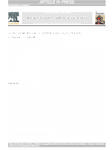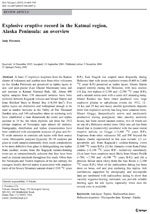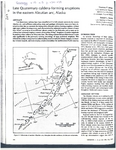Kaguyak CFE
Start: 5800 yBP ± 200 Years [1]
Event Type: Explosive
Max VEI: 5 [2]
Description: From Miller and Smith (1987): "Kaguyak crater is a small (2.6 km diameter), little-known, lake-filled, circular caldera in the northeast corner of the [Katmai National] park (Fig. 1 [in original text]). Nonwelded ash-flow tuffs are confined to within 7 km of the caldera and do not appear to have been particularly mobile. The ash flows filled previously glaciated valleys..."
From Fierstein (2007): "A dacitic Plinian eruption blanketed at least 120 km2 with a moderate-sized ignimbrite during the caldera-forming eruption at Kaguyak, 70 km NE of Mount Katmai. Although the accompanying coarse plinian fallout is not widely preserved (and may never have been widely dispersed), the coignimbrite ash elutriated during emplacement of the ignimbrite is a widespread marker bed in the region (see discussion of "Bright orange fine ash" [in original text]). Microprobe analyses of magnetites from this ejecta are distinctively low TiO2, and glass shards are distinctively low in K2O and high in CaO at 75.5-78.5% SiO2, which clearly distinguishes them from ejecta of all other Katmai volcanoes (Figs. 5, 13 [in original text]). Many radiocarbon dates from locations between Windy Creek and Kaguyak caldera constrain the collapse event to 5,800 14C years B.P."
"Eruption volumes are poorly constrained for this caldera-forming event due to patchy preservation and/or exposure...Deposits within 10 km of vent are all pumice falls, shed from (what was likely) a (sub)plinian column. Beyond 25 km from vent, the fallout is a fine-grained bright orange layer that is largely coignimbrite ash. Thickness data used in volume calculations (after Fierstein and Nathenson, 1992) yield an estimate of ~0.3 km3 within the moderately constrained 9-cm isopach and another 0.4 km3 within the less well constrained 3-cm isopach. Although distal ash distribution is poorly constrained, we draw tentative isopachs to 1.5 cm that include the well-correlated tephra on the Kenai Peninsula and the less well correlated tephra on Afognak Island and Kukak Bay (Fig. 1; see Section 8.1.3 [in original text]). This could add as much as 2.8 km3 to the fall volume, for a total tephra fallout volume of as much as ~3.5 km3 (~1.5 km3 DRE)."
The Global database on large magnitude explosive volcanic eruptions (LaMEVE; 2017) reports a magnitude of 6.500, bulk eruptive volume of 3.900cubic km and a dense rock equivalent eruptive volume of 1.200 cubic km for the eruption.
From Fierstein (2007): "A dacitic Plinian eruption blanketed at least 120 km2 with a moderate-sized ignimbrite during the caldera-forming eruption at Kaguyak, 70 km NE of Mount Katmai. Although the accompanying coarse plinian fallout is not widely preserved (and may never have been widely dispersed), the coignimbrite ash elutriated during emplacement of the ignimbrite is a widespread marker bed in the region (see discussion of "Bright orange fine ash" [in original text]). Microprobe analyses of magnetites from this ejecta are distinctively low TiO2, and glass shards are distinctively low in K2O and high in CaO at 75.5-78.5% SiO2, which clearly distinguishes them from ejecta of all other Katmai volcanoes (Figs. 5, 13 [in original text]). Many radiocarbon dates from locations between Windy Creek and Kaguyak caldera constrain the collapse event to 5,800 14C years B.P."
"Eruption volumes are poorly constrained for this caldera-forming event due to patchy preservation and/or exposure...Deposits within 10 km of vent are all pumice falls, shed from (what was likely) a (sub)plinian column. Beyond 25 km from vent, the fallout is a fine-grained bright orange layer that is largely coignimbrite ash. Thickness data used in volume calculations (after Fierstein and Nathenson, 1992) yield an estimate of ~0.3 km3 within the moderately constrained 9-cm isopach and another 0.4 km3 within the less well constrained 3-cm isopach. Although distal ash distribution is poorly constrained, we draw tentative isopachs to 1.5 cm that include the well-correlated tephra on the Kenai Peninsula and the less well correlated tephra on Afognak Island and Kukak Bay (Fig. 1; see Section 8.1.3 [in original text]). This could add as much as 2.8 km3 to the fall volume, for a total tephra fallout volume of as much as ~3.5 km3 (~1.5 km3 DRE)."
The Global database on large magnitude explosive volcanic eruptions (LaMEVE; 2017) reports a magnitude of 6.500, bulk eruptive volume of 3.900cubic km and a dense rock equivalent eruptive volume of 1.200 cubic km for the eruption.
References Cited
[1] Kaguyak dome field and its Holocene caldera, Alaska Peninsula, 2008
Fierstein, Judy, and Hildreth, Wes, 2008, Kaguyak dome field and its Holocene caldera, Alaska Peninsula: Journal of Volcanology and Geothermal Research, v. 177, n. 2, p. 340-366, doi:10.1016/j.jvolgeores.2008.05.016 .[2] Volcanoes of the World, 2013
Global Volcanism Program, 2013, Volcanoes of the World, v. 4.5.3. Venzke, E (ed.): Smithsonian Institution. Downloaded 2017. http://dx.doi.org/10.5479/si.GVP.VOTW4-2013[3] Late Quaternary caldera-forming eruptions in the eastern Aleutian arc, Alaska, 1987
Miller, T. P., and Smith, R. L., 1987, Late Quaternary caldera-forming eruptions in the eastern Aleutian arc, Alaska: Geology, v. 15, n. 5, p. 434-438.[4] Explosive eruptive record in the Katmai region, Alaska Peninsula: an overview, 2007
Fierstein, Judy, 2007, Explosive eruptive record in the Katmai region, Alaska Peninsula: an overview: Bulletin of Volcanology, v. 69, n. 5, p. 469-509, doi:10.1007/s00445-006-0097-y.[5] Global database on large magnitude explosive volcanic eruptions (LaMEVE), 2012
Crosweller H.S., Arora, B., Brown, S.K., Cottrell, E., Deligne, N.I., Guerrero, N.O., Hobbs, L., Kiyosugi, K., Loughlin, S.C., Lowndes, J., Nayembil, M., 2012, Global database on large magnitude explosive volcanic eruptions (LaMEVE): Journal of Applied Volcanology, v. 1, n. 4, unpaged.Complete Eruption References
Volcanoes of the World, 2013
Global Volcanism Program, 2013, Volcanoes of the World, v. 4.5.3. Venzke, E (ed.): Smithsonian Institution. Downloaded 2017. http://dx.doi.org/10.5479/si.GVP.VOTW4-2013
Global database on large magnitude explosive volcanic eruptions (LaMEVE), 2012
Crosweller H.S., Arora, B., Brown, S.K., Cottrell, E., Deligne, N.I., Guerrero, N.O., Hobbs, L., Kiyosugi, K., Loughlin, S.C., Lowndes, J., Nayembil, M., 2012, Global database on large magnitude explosive volcanic eruptions (LaMEVE): Journal of Applied Volcanology, v. 1, n. 4, unpaged.
Kaguyak dome field and its Holocene caldera, Alaska Peninsula, 2008
Fierstein, Judy, and Hildreth, Wes, 2008, Kaguyak dome field and its Holocene caldera, Alaska Peninsula: Journal of Volcanology and Geothermal Research, v. 177, n. 2, p. 340-366, doi:10.1016/j.jvolgeores.2008.05.016 .

Explosive eruptive record in the Katmai region, Alaska Peninsula: an overview, 2007
Fierstein, Judy, 2007, Explosive eruptive record in the Katmai region, Alaska Peninsula: an overview: Bulletin of Volcanology, v. 69, n. 5, p. 469-509, doi:10.1007/s00445-006-0097-y.

Age of formation of Kaguyak Caldera, eastern Aleutian Arc, Alaska, estimated by tephrochronology, 1998
Riehle, J. R., Waitt, R. B., Meyer, C. E., and Calk, L. C., 1998, Age of formation of Kaguyak Caldera, eastern Aleutian Arc, Alaska, estimated by tephrochronology: in Gray, J. E. and Riehle, J. R., (eds.), Geologic studies in Alaska by the U.S. Geological Survey, 1996, U.S. Geological Survey Professional Paper PP 1595, p. 161-168.

Late Quaternary caldera-forming eruptions in the eastern Aleutian arc, Alaska, 1987
Miller, T. P., and Smith, R. L., 1987, Late Quaternary caldera-forming eruptions in the eastern Aleutian arc, Alaska: Geology, v. 15, n. 5, p. 434-438.
